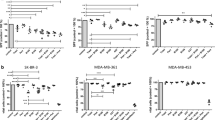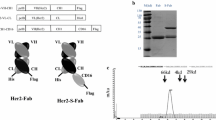Abstract
Amygdalin induces apoptotic death in several carcinoma cells. Affibody is an engineered protein with a high affinity for human epidermal receptor 2 (HER2). We assessed the cytotoxic effects of the amygdalin-ZHER2 affibody conjugate on two breast carcinoma cell lines. The ZHER2 affibody gene was synthesized and transferred into E. coli BL21 as an expression host. After purification, the ZHER2 affibody was conjugated to amygdalin. The cytotoxic effects of amygdalin and its ZHER2 affibody conjugate on the SK-BR-3, with overexpression of HER2, and MCF-7 cells were evaluated by MTT assay. The effects of amygdalin and its conjugate on apoptotic death and expression of pro-apoptotic Bax and anti-apoptotic Bcl-2 proteins were measured. Amygdalin individually showed a potent cytotoxic effect against both MCF-7 (IC50 = 14.2 mg ml−1) and SK-BR-3 cells (IC50 = 13.7 mg ml−1). However, the amygdalin-ZHER2 affibody conjugate had a more cytotoxic effect on SK-BR-3 (IC50 = 8.27 mg ml−1) than MCF-7 cells (IC50 = 19.8 mg ml−1). Amygdalin had a significant apoptotic effect on both cell lines and the effect of its conjugate on SK-BR-3 cells was significantly more potent than MCF-7 cells. Amygdalin increased Bax and decreased Bcl-2 expression in both cell lines. However, the effect of its conjugate on the Bax and Bcl-2 expression in SK-BR-3 was more potent than MCF-7 cells. In conclusion, the amygdalin-ZHER2 affibody conjugate may be considered as a valuable candidate for specific treatment of breast cancer patients with overexpression of HER2. However, further in vivo studies are required to explain the antitumoral effects of constructed amygdalin-ZHER2 affibody conjugate.










Similar content being viewed by others
References
Holzbecher MD, Moss MA, Ellenberger HA (1984) The cyanide content of laetrile preparations, apricot, peach and apple seeds. J Toxicol Clin Toxicol 22(4):341–347
Santos Pimenta LP, Schilthuizen M, Verpoorte R, Choi YH (2014) Quantitative analysis of amygdalin and prunasin in Prunus serotina Ehrh. using 1H-NMR spectroscopy. Phytochem Anal 25(2):122–126
Zhou C, Qian L, Ma H, Yu X, Zhang Y, Qu W et al (2012) Enhancement of amygdalin activated with β-d-glucosidase on HepG2 cells proliferation and apoptosis. Carbohydr Polym 90(1):516–523
Wodinsky I, Swiniarski J (1975) Antitumor activity of amygdalin MF (NSC-15780) as a single agent and with beta-glucosidase (NSC-128056) on a spectrum of transplantable rodent tumors. Cancer Chemother Rep 59(5):939–950
Blaheta RA, Nelson K, Haferkamp A, Juengel E (2016) Amygdalin, quackery or cure? Phytomedicine 23(4):367–376
Moertel CG, Fleming TR, Rubin J, Kvols LK, Sarna G, Koch R et al (1982) A clinical trial of amygdalin (Laetrile) in the treatment of human cancer. N Engl J Med 306(4):201–206
Saleem M, Asif J, Asif M, Saleem U (2018) Amygdalin from apricot kernels induces apoptosis and causes cell cycle arrest in cancer cells: an updated review. Anti-Cancer Agents Med Chem 18(12):1650–1655
Nielsen DL, Andersson M, Kamby C (2009) HER2-targeted therapy in breast cancer. Monoclonal antibodies and tyrosine kinase inhibitors. Cancer Treat Rev 35(2):121–136
Mohamed A, Krajewski K, Cakar B, Ma CX (2013) Targeted therapy for breast cancer. Am J Pathol 183(4):1096–1112
Nami B, Maadi H, Wang Z (2018) Mechanisms underlying the action and synergism of trastuzumab and pertuzumab in targeting HER2-positive breast cancer. Cancers 10(10):342
Riccio G, Coppola C, Piscopo G, Capasso I, Maurea C, Esposito E et al (2016) Trastuzumab and target-therapy side effects: Is still valid to differentiate anthracycline Type I from Type II cardiomyopathies? Hum Vaccines Immunother 12(5):1124–1131
Von Minckwitz G, Huang C-S, Mano MS, Loibl S, Mamounas EP, Untch M et al (2019) Trastuzumab emtansine for residual invasive HER2-positive breast cancer. N Engl J Med 380(7):617–628
Alley SC, Okeley NM, Senter PD (2010) Antibody–drug conjugates: targeted drug delivery for cancer. Curr Opin Chem Biol 14(4):529–537
Phillips GDL, Li G, Dugger DL, Crocker LM, Parsons KL, Mai E et al (2008) Targeting HER2-positive breast cancer with trastuzumab-DM1, an antibody–cytotoxic drug conjugate. Cancer Res 68(22):9280–9290
Ghanemi M, Pourshohod A, Ghaffari MA, Amin M, Zeinali M, Jamalan M (2019) Specific targeting of HER2-positive head and neck squamous cell carcinoma line HN5 by Idarubicin-ZHER2 affibody conjugate. Curr Cancer Drug Targets 19(1):65–73
Hansson M, Ringdahl J, Robert A, Power U, Goetsch L, Nguyen TN et al (1999) An in vitro selected binding protein (affibody) shows conformation-dependent recognition of the respiratory syncytial virus (RSV) G protein. Immunotechnology 4(3–4):237–252
Frejd FY, Kim K-T (2017) Affibody molecules as engineered protein drugs. Exp Mol Med 49(3):e306
Eigenbrot C, Ultsch M, Dubnovitsky A, Abrahmsén L, Härd T (2010) Structural basis for high-affinity HER2 receptor binding by an engineered protein. Proc Natl Acad Sci USA 107(34):15039–15044
Richards DA (2018) Exploring alternative antibody scaffolds: antibody fragments and antibody mimics for targeted drug delivery. Drug Discov Today: Technol 30:35–46
Tai W, Mahato R, Cheng K (2010) The role of HER2 in cancer therapy and targeted drug delivery. J Control Release 146(3):264–275
Puri A, Kramer-Marek G, Campbell-Massa R, Yavlovich A, Tele SC, Lee S-B et al (2008) HER2-specific affibody-conjugated thermosensitive liposomes (Affisomes) for improved delivery of anticancer agents. J Liposome Res 18(4):293–307
Bradford MM (1976) A rapid and sensitive method for the quantitation of microgram quantities of protein utilizing the principle of protein-dye binding. Anal Biochem 72(1–2):248–254
Hermanson G (2008) Bioconjugate techniques, 2nd edn. Academic Press, London
Van Meerloo J, Kaspers GJ, Cloos J (2011) Cell sensitivity assays: the MTT assay. Cancer cell culture. Springer, Cham, pp 237–245
Lee HM, Moon A (2016) Amygdalin regulates apoptosis and adhesion in Hs578T triple-negative breast cancer cells. Biomol Ther 24(1):62
Shounan Y, Feng X, O'Connell PJ (1998) Apoptosis detection by annexin V binding: a novel method for the quantitation of cell-mediated cytotoxicity. J Immunol Methods 17(1–2):61–70
Szöllösi J, Balázs M, Feuerstein BG, Benz CC, Waldman FM (1995) ERBB-2 (HER2/neu) gene copy number, p185HER-2 overexpression, and intratumor heterogeneity in human breast cancer. Cancer Res 55(22):5400–5407
Park H-J, Yoon S-H, Han L-S, Zheng L-T, Jung K-H, Uhm Y-K et al (2005) Amygdalin inhibits genes related to cell cycle in SNU-C4 human colon cancer cells. World J Gastroenterol 11(33):5156
Chen Y, Ma J, Wang F, Hu J, Cui A, Wei C et al (2013) Amygdalin induces apoptosis in human cervical cancer cell line HeLa cells. Immunopharmacol Immunotoxicol 35(1):43–51
Makarević J, Rutz J, Juengel E, Kaulfuss S, Reiter M, Tsaur I et al (2014) Amygdalin blocks bladder cancer cell growth in vitro by diminishing cyclin A and cdk2. PLoS ONE 9(8):e105590
Song Z, Xu X (2014) Advanced research on anti-tumor effects of amygdalin. J Cancer Res Ther 10(5):3
Chang H-K, Shin M-S, Yang H-Y, Lee J-W, Kim Y-S, Lee M-H et al (2006) Amygdalin induces apoptosis through regulation of Bax and Bcl-2 expressions in human DU145 and LNCaP prostate cancer cells. Biol Pharm Bull 29(8):1597–1602
Qian L, Xie B, Wang Y, Qian J (2015) Amygdalin-mediated inhibition of non-small cell lung cancer cell invasion in vitro. Int J Clin Exp Pathol 8(5):5363
Juengel E, Thomas A, Rutz J, Makarevic J, Tsaur I, Nelson K et al (2016) Amygdalin inhibits the growth of renal cell carcinoma cells in vitro. Int J Mol Med 37(2):526–532
Zhang Y, Jiang S, Zhang D, Bai X, Hecht SM, Chen S (2017) DNA–affibody nanoparticles for inhibiting breast cancer cells overexpressing HER2. Chem Commun 53(3):573–576
Orlova A, Magnusson M, Eriksson TL, Nilsson M, Larsson B, Höidén-Guthenberg I et al (2006) Tumor imaging using a picomolar affinity HER2 binding affibody molecule. Cancer Res 66(8):4339–4348
Golmohammadzadeh G, Aghajanshakeri S, Ahangar N (2017) An overview of the most common methods for assessing cell viability. J Res Med Dent Sci 5(2):33
Ekerljung L, Lindborg M, Gedda L, Frejd FY, Carlsson J, Lennartsson J (2008) Dimeric HER2-specific affibody molecules inhibit proliferation of the SKBR-3 breast cancer cell line. Biochem Biophys Res Commun 377(2):489–494
Ricart AD, Tolcher AW (2007) Technology insight: cytotoxic drug immunoconjugates for cancer therapy. Nat Clin Pract Oncol 4(4):245–255
de Melo GD, Jardim DLF, Marchesi MSP, Hortobagyi GN (2016) Mechanisms of resistance and sensitivity to anti-HER2 therapies in HER2+ breast cancer. Oncotarget 7(39):64431
Alexis F, Basto P, Levy-Nissenbaum E, Radovic-Moreno AF, Zhang L, Pridgen E et al (2008) HER-2 targeted nanoparticle-affibody bioconjugates for cancer therapy. ChemMedChem 3(12):1839
Alavizadeh SH, Akhtari J, Badiee A, Golmohammadzadeh S, Jaafari MR (2016) Improved therapeutic activity of HER2 Affibody-targeted cisplatin liposomes in HER2-expressing breast tumor models. Expert Opin Drug Deliv 13(3):325–336
Mohammad RM, Muqbil I, Lowe L, Yedjou C, Hsu H-Y, Lin L-T et al (2015) Broad targeting of resistance to apoptosis in cancer. Semin Cancer Biol 35:S78–S103
Fulda S, Debatin K-M (2006) Extrinsic versus intrinsic apoptosis pathways in anticancer chemotherapy. Oncogene 25(34):4798–4811
Ola MS, Nawaz M, Ahsan H (2011) Role of Bcl-2 family proteins and caspases in the regulation of apoptosis. Mol Cell Biochem 351(1–2):41–58
Ghoncheh M, Pournamdar Z, Salehiniya H (2016) Incidence and mortality and epidemiology of breast cancer in the world. Asian Pac J Cancer Prev 17(S3):43–46
Clark GM, McGuire WL (1991) Follow-up study of HER-2/neu amplification in primary breast cancer. Cancer Res 51(3):944–948
Simon R, Nocito A, Hübscher T, Bucher C, Torhorst J, Schraml P et al (2001) Patterns of her-2/neu amplification and overexpression in primary and metastatic breast cancer. J Natl Cancer Inst 93(15):1141–1146
Acknowledgements
This paper is issued from the Ph.D. thesis of Bahman MoradiPoodeh and financial support was provided by Hyperlipidemia Research Center, Ahvaz Jundishapur University of Medical Sciences, Ahvaz, Iran (Grant No. HLRC-9602).
Funding
This study was funded by Hyperlipidemia Research Center, Ahvaz Jundishapur University of Medical Sciences, Ahvaz, Iran (Grant Number HLRC-9602).
Author information
Authors and Affiliations
Corresponding author
Ethics declarations
Conflict of interest
The authors declare no conflict of interest.
Research involving human and/or animal rights
This article does not contain any studies with human participants or animals performed by any of the authors.
Additional information
Publisher's Note
Springer Nature remains neutral with regard to jurisdictional claims in published maps and institutional affiliations.
Rights and permissions
About this article
Cite this article
Moradipoodeh, B., Jamalan, M., Zeinali, M. et al. Specific targeting of HER2-positive human breast carcinoma SK-BR-3 cells by amygdaline-ZHER2 affibody conjugate. Mol Biol Rep 47, 7139–7151 (2020). https://doi.org/10.1007/s11033-020-05782-z
Received:
Accepted:
Published:
Issue Date:
DOI: https://doi.org/10.1007/s11033-020-05782-z




